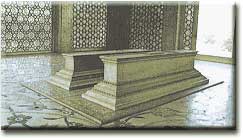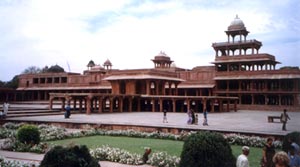|

Agra

Perhaps no other historical monument has evoked
as much awareness and admiration from tourists and travelers alike, as the
magnificent Taj Mahal - fondly called by people as the ultimate requiem of love,
from a great Mughal Emperor to his beloved. So overwhelming is the exquisite beauty and
presence of this marble mausoleum that centuries later today, even the very land
where it has been located - Agra - has been immortalized as the City of the Taj.
Yet, it doesn’t take much for the roving eye to discover that there's more to
Agra than just the fabled Taj Mahal. The city is a
virtual gateway to a world of discovery… a freeze-frame from a resplendent era
that's long since gone by. In the great epic 'Mahabharat' the
region of Agra is described as 'Agraban' (an integral part of the
Braj Bhumi or the land of Lord Krishna). The latter part of Indian history
outlines the origins of Agra to 1475 A.D., when the reign of Raja Badal Singh. Top However, Agra came into limelight during the
rule of Afghan King Sikandar Lodhi - who had made it the capital of his empire. Later in 1526 A.D., the Mughal Emperor Babar
took upon himself the task for rendering Agra, a unique character and beauty of
its own. The visionary that he was and a great patron of the arts, Emperor
Babar brought in a change in the culture and lifestyle among the people of
Agra, which then brought forth some of the finest craftsmen, artists, statesmen,
warriors and nobility, this part of India had ever witnessed. The golden age of
Agra's history, thus began to set in. The next few hundred years of Agra witnessed
the rise of the pomp and pageantry of three great Mughal monarchs - Emperor
Akbar, Jahangir and ShahJahan - all of whom lavished on this
fabled city, their love and riches immeasurable to transform the land into one
of the great centers of art, culture, learning and commerce. Much of the city's impressive past lives in
evidence even today, in the hunting presence inside the monuments, the majesty
of the buildings, the exquisite arts and crafts and not to forget, the lure of
an exceptional cuisine… all, cherished as priceless legacies of a nostalgic
past. The older city of Agra has impressively retained much of its resplendent
history… captivating every visitor with fond memories to take back home.
Today, luxury and modern convenience also exist adjacent to tradition - luxury
hotels, shopping malls and plazas, wide avenues and a superb choice of venues
for recreation, business, sports, pleasure, education and the arts. Top Places of
Interest Agra Fort Among the other monuments that Agra takes
pride in is the Agra Fort, built by three of the greatest
Mughal emperors. The construction of this massive structure began in 1565, under
Akbar, and continued till the time of his grandson, Shahjahan.
Armed with massive double walls, punctuated by four gateways, the fort houses
palaces, courts, mosques, baths, gardens and gracious pavilions within its
premises. Among the fascinating structures that are to be found within the fort
is the red sandstone Jehangiri Mahal built by Akbar for his Hindu queen, Jodhabai,
was one of the earliest constructions illustrating the fort's change from a
military structure to a palace. The palace is also notable for its smooth
blending of Hindu and central Asian architectural styles. The Diwan - i - Am,
the Diwan - i - Khas, the Khas Mahal, The Palace of Mirrors,
The Pearl mosque, the Nagina Masjid, the Garden of Grapes, and the
Fish Pavilion are the other monuments in the fort complex Itmad-ud-daulah Tomb  The
Itmad-ud-daulah tomb stands in the centre of a grand Persian garden, an
architectural gem of its times. It is the tomb of Mirza Ghiyas Beg,
Emperor Jahangir's wazir, or Chief Minister, and also his father - in- law. The
structure was built by Empress Noorjehan, between 1622 and 1628 and is very
similar to the tomb she constructed for her husband, near Lahore in Pakistan.
This splendid garden tomb is believed to be the precursor of the magnificent Taj
Mahal, and was the first Mughal structure to be built entirely of marble,
and the first, again, to make use of pietra dura, the inlay marble work that
came to be typical of the Taj. Near the Agra Fort, is Jami
Masjid, built by Shahjahan in 1648. An inscription over its main
entrance indicates that it was built in the name of Jahanara, the emperor's
daughter, who was imprisoned with the hapless emperor by Aurangzeb. Top Sikandara 10
km north of Agra lies Akbar's tomb, in Sikandra. Named after the Afghan
ruler Sikander Lodi, Sikandra is the final resting place of Emperor
Akbar. Akbar began the construction of his own garden mausoleum
during his lifetime, a red sandstone structure in a chahar - bagh, or 4 - square
formal garden. An impressive marble - inlaid gateway leads to the spacious four
- tiered monument which is crowned by a white marble cenotaph and screen. This
last was added by Jahangir, who completed the tomb after the demise of
his father. 40 km west of Agra, is the perfectly preserved 'phantom city' of Fatehpur
Sikri. Between 1570 and 1586, during Akbar's reign, the city served as
the capital of the Mughal empire, and was then abruptly abandoned. Today, albeit
deserted, the city's palaces, courts and other monuments stand in mute testimony
to the greatness, and amazing vision of the greatest emperor of all times, who
was also a fine human being. Tomb of Sheikh Salim Chisti The dargah or tomb of Sheikh Salim
Chisti, the renowned saint, set in the courtyard of the Royal Mosque,
still draws hordes of pilgrims who come to have their wishes fulfilled. Bharatpur 55
kilometers from Agra is Bharatpur, which has an early
18th century Rajput Fort, but is better known, today, for one of the
finest bird sanctuaries in the world. Called Keoladeo Ghana, the sanctuary is a
40 sq. km area of swampy light - wooded terrain, which was once the private
hunting and shooting preserve of the Maharaja of Bharatpur. Today, it is
the protected breeding ground of hundreds of species of birds and home to
migratory birds, especially the Siberian Crane, that spend their winters here. Top Diwan-i-Aam Within the center of the fort is the Hall of Public Audience, built
by Shah Jahan. It replaced an earlier wooden structure. It is a pavillion
supported by 40 carved pillars where the emperor once sat in state, consulting
with officials and receiving petitioners. Other than the Diwan-i-Aam. There is
the small Nagina Masjid or Gem Mosque. Nearby is the Ladies Bazaar, where female
merchants came to sell to the ladies of the Mughal court. Diwan-i-Khas It was fort's true citadel of power, also built by Shah
Jahan, between 1636 and
1637. The Hall of Private Audience glittered with solid gold, silver and
precious stones, and was the site where the emperor received important
diginitaries or foreign ambassadors. The famous Peacock throne was kept here
before being moved to Delhi by Aurangzeb. Nearby are the Khas Mahal, Shah Jahan
private pavillions. Lookout for the Sheesh Mahal the royal bathing quarters,
where the light of a single lamp is reflected in thousands of tiny mirrors
embedded in the walls and ceiling. Musamman
Burj or Jasmine Tower : This exquisite octagonal tower, standing
close to the Diwan-i-Khas, is the place where Shah Jahan died as captive of his
son Aurangzeb, passing his last days gazing at the Taj (the tomb of his beloved
wife). The Mina Masjid was Shah Jahan's private mosque during his imprisonment. Top Jahangir's Palace Built by
Akbar, for his son Jahangir, it was the largest private residence in
the fort. Its a blend of Hindu and Central Asian architectural styles. Among other important
attractions are Anguri Bagh, Hauz-i-Jehangiri and Delhi Gate. The first, the
Grape Garden was in all probability just a small, formal Mughal Garden. It stand
in front of the Khas Mahal. Hauz-i-Jehangiri, located in front of Jehangir's
palace, is a huge bowl beautifully carved out of a single block of stone. It is
fabled to have been used for preparing bhang. Jama
Masjid : Built by Shah Jahan in 1648, it was built in the name of
Jahanara, Shah Jahan's favourite daughter. She was also imprisoned with Shah
Jahan by Aurangzeb. This mosque is without any minarets. It's sandstone domes
have superb marble patterning. Chini
Ka Ranza : Located about a km north of
Itimad-ud-Daulah, the
mausoleum of Afral Khan, a poet and official in the court of Shah Jahan. The
China Tomb is notable for its giant enamelled dome. Babur's
Ram Bagh : About 2 km north along the Yamuna's side lies this
Bagh,
laid out in 1528. Probably, it is the oldest of India's Mughal Garden. According
to some traditions, this was the place where Babur was temporarily buries before
being permanently interred at Kabul in Afghanistan as per his wishes. Fatehpur
Sikri  Was
Akbar's capital for approximately 12 years. Akbar selected Sikri as the seat of
his government believing it to be auspicious for himself. He experimented both
with architecture and art and built a city expressing his ideals and vision.
Today, Fatehpur Sikri is a deserted, phantom city. But the inner citadel is
immaculately preserved. The finest monuments within this area are the Diwan-i-Am,
Diwan-i-Khas, Panch Mahal, Buland Darwaza and the tomb of Saint Sheikh Salim
Chishti, and the Jama Masjid (one of the largest mosques In India). Was
Akbar's capital for approximately 12 years. Akbar selected Sikri as the seat of
his government believing it to be auspicious for himself. He experimented both
with architecture and art and built a city expressing his ideals and vision.
Today, Fatehpur Sikri is a deserted, phantom city. But the inner citadel is
immaculately preserved. The finest monuments within this area are the Diwan-i-Am,
Diwan-i-Khas, Panch Mahal, Buland Darwaza and the tomb of Saint Sheikh Salim
Chishti, and the Jama Masjid (one of the largest mosques In India).
Top
|
|



